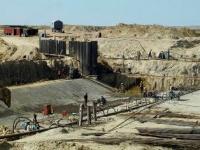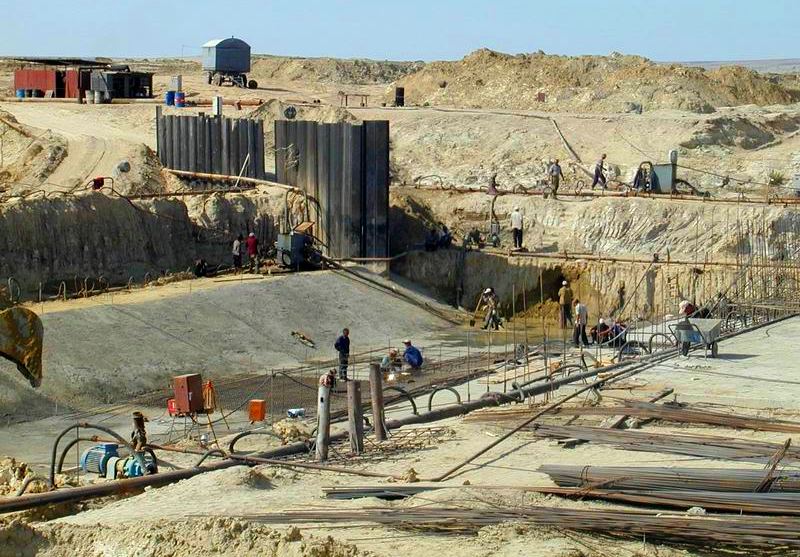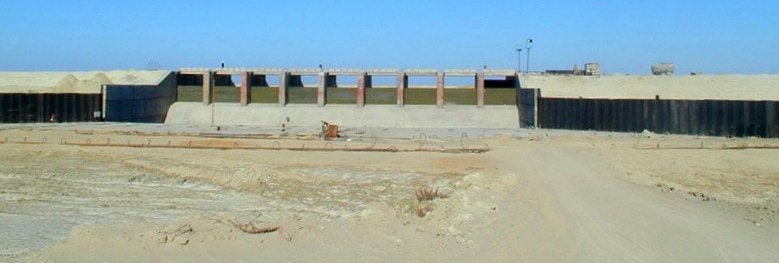You are here
Construction of Kokaral dam.

Excursions on North Aral.
"In the summer ... the heat is unbearable, without rain, and the air is cleaned only by the prevailing winds ... At sea, these winds make sailing very difficult: they often endangered us ... and forced us to risks that often went beyond prudence"
Alexey Ivanovich Butakov.
Trip to Kokaral dam.
The Kokaral dam is a dam that stops the Berga Strait between the North Aral Sea (Small Sea) and the South Aral Sea (Big Sea). Kokaralsky dam is designed to control the water level in the Small Sea. The length of the dam is 13,034 m, the width is up to 100 - 150 m.
The height of the dam crest is 6 m (45.5 m abs), the filling of the Small Sea is supposed to reach 42.2 m abs. A dam was constructed at the dam with nine spillways with a throughput of 600 m³ / s, designed to protect it from destruction by dumping excess water into the South Aral.
Everyone knows the phrase that has become commonplace: "Water is life." The Soviet scientist Mark Lvovich proposed creating instead of the shrinking Aral Sea two reservoirs - the Northern Aral and the Western. After the construction of the Kokaral lintel from the former Kokaral island to the Syr Darya delta, the level of the Northern Aral began to rise rapidly.
Almost half of the Aral Sea is located in Kazakhstan. It was our country that came up with the initiative to bring the Northern Aral to life. An agreement was concluded with the World Bank on financing the project “Regulation of the Syrdarya Riverbed and Preservation of the Northern Aral Sea”.
In 2004, the construction of the Kokaral lintel was completed. After clearing the main channel and channels of the Syr Darya delta, this river again began to reach the sea. In the Northern Aral Sea region startling changes have begun.
In the late 80s of the XX century, due to the shallowing of the Aral Sea, its northern part was separated from the southern. Water along the narrow channel remaining between them flowed from the Small Aral to the Big. They tried to build a dam that overlaps this channel twice.
The first, sandy, was built in 1992, but in the spring of 1993, due to the increase in the level, it was destroyed. Local construction enterprises and executive bodies have found funds to create a new dam. In the spring of 1997, the second dam, also sandy, was completed.
A spillway was built on it. In 1998, it was reinforced with reinforced concrete slabs. After its construction, the area of the northern part of the sea increased significantly, which caused a decrease in the frequency of dust storms and salt removal from Aralkum to adjacent areas.
The populations of fish (bream, common carp, Aral sturgeon) from the hatchery were restored, then only Glossa flounder lived in salt water. In 1999, due to rising water levels, this dam was destroyed by a storm. In 2001, the government of Kazakhstan turned to the World Bank with a request for a loan to build a full-fledged dam.
Dam construction was completed in August 2005. Water level in the Northern Aral increased by 12 meters compared to its lowest level recorded in 2003, salinity decreased. Already in 2006, earlier than scientists expected, an increase in the level was recorded.
Mineralization of water decreased - from 23 to 17 grams per liter. The number of fish and its species diversity increased, the microclimate began to change. The distance from Aralsk to the sea was reduced from 100 to 25 km.
The dam suspended the flow of the Syr Darya into the South Sea and accelerated its drying. It was divided into Eastern and Western Aral, at the same time Tushybas Bay was separated. Within the framework of the RCAM-2 project, it is planned to increase the dam height by 6 - 8 meters, while the volume of water in the Northern Aral will increase from 27 kilometers cubic to 59 kilometers cubic, and the salinity of the water will decrease from 17 g / l to 2.5 - 3 g / l.
This will allow the waters of the Small Aral Sea to come close to the former port of Aralsk and significantly improve the economic and environmental situation in the region. According to the calculations of the designers, the filling of the Northern Aral Sea should have been gradual, within one and a half to two years after the completion of construction, but the inflow of water to the Syr Darya turned out to be more than expected, and already in 2005 the reservoir began to fill rapidly.
The sea began to return. In 2005, the Aral-Syrdarya Basin Fish Inspection was revived. It not only monitors compliance with fishery quotas on the volumes of prey, not only suppresses attempts of poaching, but also, if necessary, conducts “careful reclamation fishing”.
This is due to the fact that through the floodgates in the dam leaves a lot of fish that could die. Therefore, it is caught regularly. Commodity fish (common carp weighing 5 - 6 kg) is sent for sale, and a trifle is released in the Small Aral and lakes of the Syr Darya delta.
Suggestions were made to install fish barriers on the gateways. The Aral fleet began to revive. Applications for quotas for fishing began to come from other regions of Kazakhstan. Local ichthyology is being revived, which has completely faded over the decades of the retreat of the sea.
Scientists have noticed that in the next 10-15 years, the annual volumes of fishing in the Northern Aral Sea will reach 10-11 thousand tons. Moreover, the production of black caviar will begin, its juveniles are now grown in the Kamystabysky hatchery.
The option of creating the so-called two-level sea is proposed. In addition to the Small Aral Sea, whose upper horizon is at 42 m above sea level, it is planned to restore Saryshyganak Bay with a mark of 46 m, on the northern coast of which Aralsk is located.
To do this, it is necessary to divide the bay and the rest of the Small Aral by a dam and lay a 45-kilometer inlet channel from the Syr Darya to the north. But another option is also possible - to continue building up the Kokaral dam to the level of 46 m.
Then the need for regulation of the sea will disappear, and shipping locks in the dam will not need to be built. The region came to life, but this is only the beginning. It is necessary to take advantage of the accumulated experience and in the same way to save the Western Aral Sea - the deepest part of the once united Aral Sea.
Such a plan, by the way, was proposed by M. Lvovich. To do this, it is necessary to cut off the Western Aral from the Bolshoi Dam, to clear the channels of the Amu Darya delta and direct its water to the Western Aral. It is possible that this project will cost more, because the dam should be longer than the Kokaral lintel.


Authority:
http://ibirzha.kz







